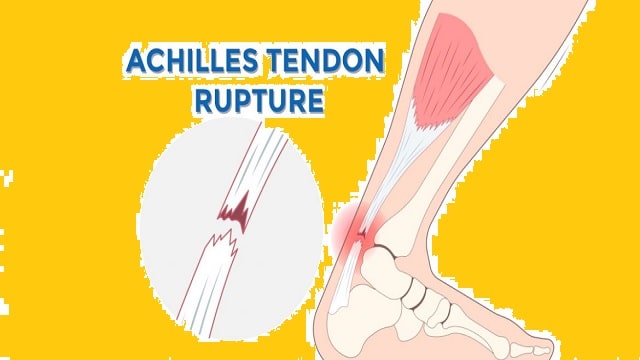An Achilles tendon injury is an injury that affects the back of the lower leg. It can happen to anyone but is most common in people who play recreational sports.
The Achilles tendon is the largest tendon in the body. It runs from the heel bone to the calf muscle. The Achilles tendon allows a person to point their toes to the floor and stand on their tiptoes.
Achilles tendon injuries are common injuries that can be mild or moderate in severity and can feel like burning pain or stiffness in the leg. If the pain is severe, there is a possibility that the Achilles tendon is partially or completely torn.
Symptoms of Achilles Tendon Injury
The most obvious symptom of an Achilles tendon injury is pain above the heel, especially when flexing the ankle or standing on your toes. The pain may be mild and may get better or worse over time. If the tendon ruptures, the pain is usually immediate and severe. The area may also feel tender, swollen, and stiff.
If the Achilles tendon is torn, there may be a snapping or popping sound when it happens. The sufferer may also experience bruising and swelling, as well as difficulty pointing the toes and pushing off the toes when taking a step.
Causes of Achilles Tendon Injuries
Achilles tendon injuries often occur in people who do activities that require them to increase speed, quickly or suddenly slow down or turn. Examples of activities that can cause Achilles tendon injuries include:
- Run.
- Gymnastics.
- Dance.
- Football.
- Baseball.
- Basketball.
- Tennis.
- Volleyball.
These injuries tend to occur when someone starts moving suddenly as they are lifting their leg rather than landing. For example, a sprinter might tear their Achilles tendon at the start of a race as they jump off the starting block. This is because the sudden movement can put too much pressure on the tendon.
Achilles tendon injuries can also occur due to repetitive stress during high-impact sports.
Risk Factors for Achilles Tendon Injury
Here are some things that can increase a person’s risk of experiencing an Achilles tendon injury:
- Wearing high heels.
- Having flat feet or what is also called flat feet, because the feet do not have an arch.
- The leg muscles or tendons are too tight.
- Has bone spurs.
- Increase the time or intensity of exercise.
- When starting a new type of exercise.
- Exercising on an uneven surface.
- Not wearing shoes that are suitable for the type of physical activity being performed.
- Taking medications called glucocorticoids or antibiotics called fluoroquinolones.
- Having a chronic condition that weakens the Achilles tendon, such as rheumatoid arthritis, lupus, gout, or diabetes.
Diagnosis of Achilles Tendon Injury
Doctors sometimes mistake an Achilles tendon injury for a sprained ankle. To make a proper diagnosis, the doctor will start with a physical exam. He or she may want to watch the patient walk or run, so he or she can look for problems that may have caused the injury.
The doctor may also perform a test called a calf squeeze test. The patient will kneel on a chair or bench or lie face down on a special table. Then, the doctor will gently press the calf muscle on the healthy leg.
That will pull on the tendon and make the foot move. Then, it will do the same thing to the other foot. If the Achilles tendon is torn, the foot will not move, because the calf muscle is not connected to the foot.
The doctor may also test the patient’s range of motion to see if they can move the ankle as they should.
In addition, examinations that can also be done are imaging tests, such as X-rays or magnetic resonance imaging (MRI). These tests can show the type of tendon damage you have and help your doctor decide the best treatment for the patient.
Achilles Tendon Injury Treatment
Mild to moderate Achilles tendon injuries usually heal on their own. To speed up the recovery process, here are some things you can do:
- Rest. Rest your feet and avoid doing heavy activities first.
- Ice. Apply ice to the injured foot for 20 minutes at a time.
- Compress. Use an elastic bandage around the lower leg and ankle to keep swelling down.
- Elevate. Place your feet on pillows to elevate them when you sit or lie down.
- Taking medication. For example, painkillers or anti-inflammatories.
- Use a heel lift. Your doctor may recommend wearing a shoe insert to help protect your Achilles tendon from further stretching.
- Do stretching and strengthening exercises, such as those recommended by your doctor or physical therapist.
However, if the Achilles tendon is torn, the doctor may recommend surgery.
Achilles Tendon Injury Complications
Complications that can occur due to Achilles tendon injury:
- Severe pain.
- Difficulty walking or being active.
- Deformation of the tendon or heel bone area.
- Tendon rupture due to re-injury.
While other complications can also occur as a result of the treatment given for Achilles tendon injuries, such as:
- Cortisone injections can sometimes cause tendon tears.
- Surgery may cause pain or infection.
Achilles Tendon Injury Prevention
Here are some steps you can try to prevent Achilles tendon injuries:
- Stretch and strengthen your calves.
- Reduce uphill running.
- Wear shoes with good support and fit.
- Stop exercising if you feel pain or tightness in the back of your calf or heel.

